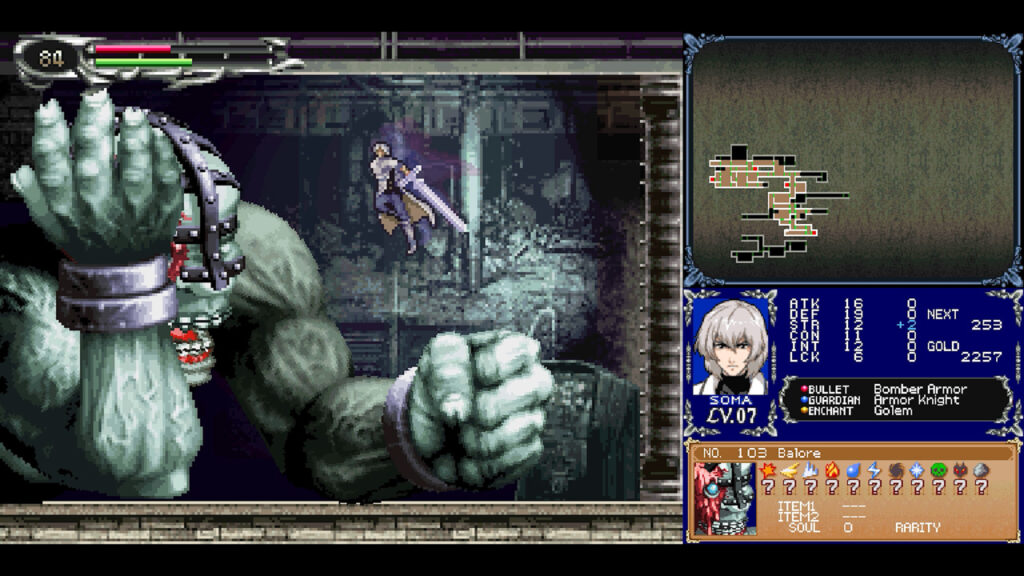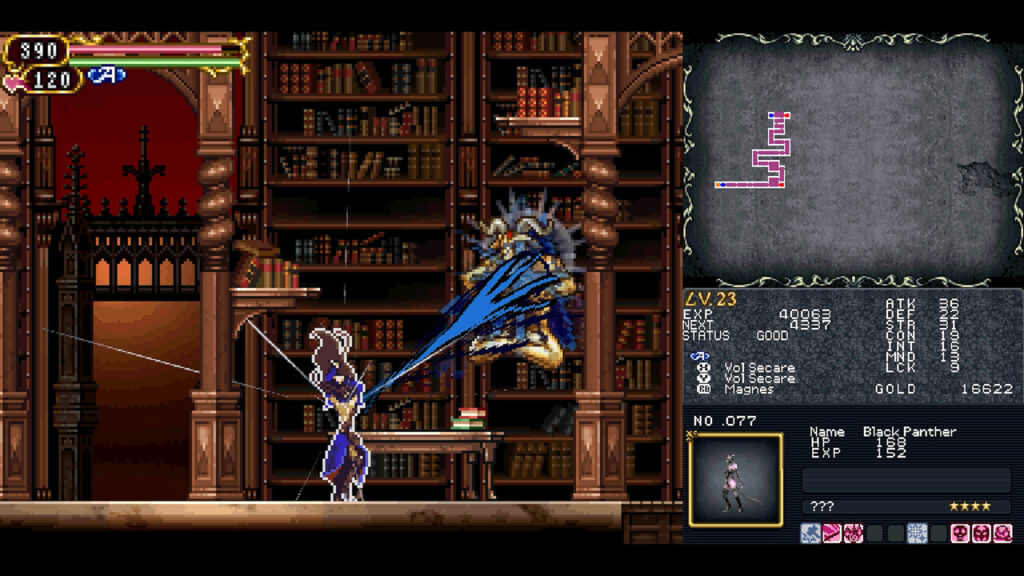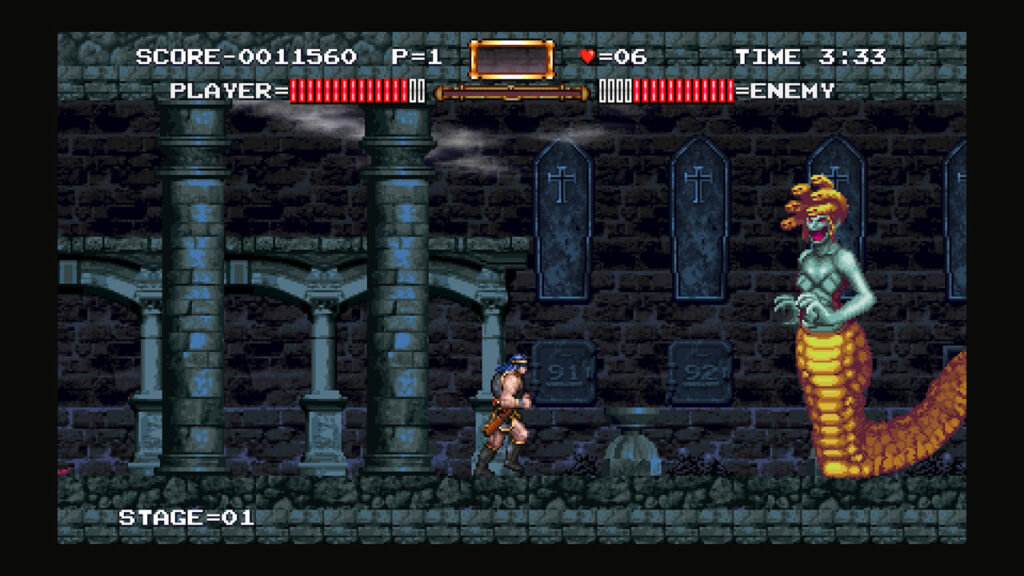More Castlevania goodness on the Nintendo Switch is always a good thing! We almost have all the 2D Castlevania on the Nintendo Switch now, so let’s dive into this beautiful collection.
The Castlevania Dominus Collection brings three of the best 2D Castlevania games to the modern era. Experience (or discover!) Castlevania: Dawn of Sorrow, Portrait of Ruin, and Order of Ecclesia in the best way possible, thanks to the addition of excellent ‘Quality of Life’ features such as quick saves, a rewind function, and much more! And get back to the roots of the series Haunted Castle Revisited, a wholly redrawn and redesigned version of the Arcade classic. I’ll cover them individually and give my final verdict at the end of the review. If you want to catch up on the previous collection (which I recommend since this one features a sequel), look at this one: Review: Castlevania Advance Collection.
Castlevania: Dawn of Sorrow
Aria and Dawn of Sorrow are probably two of my favorite Castlevania games. I love the game mechanics, the art style, and the music. For those unfamiliar with this title, Castlevania: Dawn of Sorrow is an action-adventure platform game developed and published by Konami, part of the Castlevania franchise. The game was first released on August 25, 2005, in Japan, where it’s known as Demon Castle Dracula: Cross of the Blue/Pale Moon (悪魔城ドラキュラ 蒼月の十字架 Akumajō Dracula: Sōgetsu no Jūjika?). As I said in the introduction, the game is a direct sequel to Castlevania: Aria of Sorrow, with Soma Cruz reprising his role as the protagonist; other characters from Aria of Sorrow also appear in the game, including Genya Arikado and Julius Belmont.
Plot
In 2036, one year after the events of Castlevania: Aria of Sorrow, Soma Cruz and Mina Hakuba are attacked by Celia Fortner, the priestess of an enigmatic cult (unrelated to the cult led by Aria of Sorrow’s antagonist Graham Jones) who seeks to kill Soma and revive the dark power of Dracula sleeping inside him, as a sort of retribution for Soma ‘denying his destiny’ in becoming the Dark Lord incarnate in the previous game. In the cult’s mind, Dracula represents the ultimate evil that must exist for there to be an ultimate good, and with the Dark Lord sealed, that cannot happen. But instead of running from this new threat and against Genya Arikado’s warnings, Soma decides to take the initiative and confront his foes head-on, eventually discovering a castle and monsters similar to those owned by Dracula, supposedly constructed by the cult as the scene for the ritual required to sacrifice Soma and revive the vampire lord.
Gameplay & Modes
The game has most of the same mechanics from Aria of Sorrow, like Soma Cruz’s power to soak up enemies’ souls and use their abilities. This time around, Soma can level up his skills by getting multiple copies of the same soul. A new Magic Seal System uses the touchscreen: you must draw an intriguing symbol to trap defeated boss enemies. If you don’t draw it quickly and right, the boss comes back with less power. The touchscreen also lets you bust through certain blocks and control familiars. I recommend playing this one on the Switch in handheld mode since it will make drawing the symbols easier. The docked mode features a touchscreen mode, but I did not find it practical.
In addition, the game has a multiplayer vs. mode in which one player sets up a section of the castle with enemies, and then both players race to defeat the enemies and reach the end of the level. Players can also swap the souls they’ve found in the game.
When you finish the game at a particular ending, you will unlock Julius Mode, where you can play as Julius Belmont, armed with the Vampire Killer and sub-weapons. In this mode, you can recruit two allies and switch between them at any time: Yoko Belnades, who fights with a staff and fire, ice, and lightning spells, and Alucard, who can change into a bat and has his signature sword from Symphony of the Night and hellfire spell.
Castlevania: Portrait of Ruin
It’s another indirect sequel and a very different Castlevania than the Sorrow games. Castlevania: Portrait of Ruin (悪魔城ドラキュラ ギャラリー オブ ラビリンス Akumajō Dracula: Gallery of Labyrinth?, lit. “Demon Castle Dracula: Gallery of Labyrinth”) is a platform-adventure game developed and published by Konami. It was released on November 16, 2006, in Japan and the US on December 5, 2006, for the Nintendo DS handheld game console. What made this game new was the first game in the Castlevania series to feature a cooperative multiplayer gameplay mode and the first handheld installment to have English voiceovers outside of its original Japanese release.
What makes Portrait of Ruin interesting is its time setting. The plot is set in 1944 Europe during World War II and continues the story from Castlevania: Bloodlines. The game introduces new protagonists and antagonists to the Castlevania series and expands on the two-character gameplay found in the previous Nintendo DS Castlevania title, Castlevania: Dawn of Sorrow.
Plot
In Portrait of Ruin, you are given the control of two very different characters: vampire hunter Jonathan Morris and the young sorceress Charlotte Aulin. Jonathan and Charlotte were childhood friends, both descended from legendary clans devoted to protecting mankind against the forces of evil. Jonathan Morris is the son of Castlevania: Bloodlines hero John Morris. Unlike the Belmont family, to whom they are related, the Morrises cannot use the full power of the legendary Vampire Killer whip by default. Charlotte Aulin is descended from the Belnades clan, a bloodline known for their magical prowess.
The vampire artist Brauner has revived Dracula’s Castle to bring ruin to the world, and it is up to Jonathan and Charlotte to stop him. Upon reaching the castle, the pair are met with Vincent, a priest who was sent to assist in the destruction of Castlevania. While exploring the castle, they encounter a mysterious ghost by the alias of Wind, who can impart his knowledge and skills to the pair while acting as a mentor to Jonathan. Shortly afterward, the pair discover one of Brauner’s many portraits, used to control the castle’s powers. Understanding the portrait’s composition, Charlotte deduced that to sever the link and essentially weaken Brauner, they must enter the world inside the painting and destroy the evil within. After defeating the headless knight, Dullahan, they are met with Loretta, who informs them that they have marginally weakened Brauner’s powers. And so the Portrait Labyrinth runs begin!
Gameplay
The gameplay in Portrait of Ruin is centered around the Partner System. Like Julius Mode from Castlevania: Dawn of Sorrow, players can switch freely between the two heroes to best utilize their abilities in the battle against the vampires’ army. They will also be able to combine their powers to use combo attacks. While doing so, Jonathan and Charlotte will explore environments such as Egyptian deserts and misty towns via paintings that Brauner has dispersed throughout the castle. During the adventure, the heroes will fight over 150 enemies. The duo will learn new skills as they progress and acquire equipment, relics, and items. Much of the equipment found is unique to each character (i.e., the Holy Veil is only for Charlotte, and the Samurai Helmet is only for Jonathan). This also leads to completing quests for Wind, which will grant functional new abilities or items, making the game easier. Another new combat mechanic, the Dual Crush, is also introduced in this title. This ability takes advantage of the partner system by combining the skills of the two playable characters. Certain enemies will react differently against different heroes as part of the partner system. Still, they are not necessary for the game’s completion, so pick the protagonist you are most comfortable with to play the game and switch when needed.
Castlevania: Order of Ecclesia
Welcome to my new favorite DS Castlevania (and maybe my all-time favorite Castlevania?), Castlevania Order of Ecclesia! I did not appreciate this one when it came out in 2008, mainly because it was completely different from the Castlevanias I was used to—or so I thought. It’s also tough as nails.
Castlevania: Order of Ecclesia, released in Japan as Demon Castle Dracula: The Stolen Seal (悪魔城ドラキュラ 奪われた刻印 Akumajō Dracula: Ubawareta Kokuin?), is the third Castlevania title released for the Nintendo DS handheld platform. Although developed by the same team that created Castlevania: Portrait of Ruin, this entry in the series has dropped the anime-inspired artwork of its two predecessors in favor of a more traditional Gothic style, with character design by newcomer Masaki Hirooka. It is notably the first traditional game to feature a female in the lead role named Shanoa. This is also the first canonical game in the series where the Vampire Killer does not appear in any form. The game was released on October 21, 2008 in the US and on October 23, 2008 in Japan.
Plot
Order of Ecclesia takes place after Symphony of the Night (which is that one game I still haven’t been able to play), sometime in the early 1800s. As the Belmont Clan had vanished by then, several organizations were created to research countermeasures against Dracula and his army’s eventual return. Of these organizations, the most promising was the Order of Ecclesia, which created a triad of magical glyphs named “Dominus.”
Our protagonist, Shanoa, is a young lady chosen by the order’s leader, Barlowe, as the human vessel for Dominus. Still, just before the ritual is performed, the glyphs are stolen by Shanoa’s best (and only) friend and fellow Ecclesia member, Albus, disrupting the ritual and causing Shanoa to lose her memories and emotions. Upon awakening, Barlowe tells her of the events leading to her memory loss and orders her to retrieve Albus and the stolen Dominus glyphs.
In her pursuit, Shanoa arrives at the deserted village of Wygol and finds out that Albus kidnapped its inhabitants and keeps each one imprisoned in a different location. As Shanoa rescues them throughout the game, she learns that Albus captured them to perform some twisted experiment on them, which involved draining their blood samples. Each villager rescued provides Shanoa with tasks that, once completed, offer new rewards. Although completing the tasks is not required to complete the game, some final areas are only unlocked when all villagers are rescued, so I recommend you do so.
Gameplay & Mapmechanics
The core gameplay in Castlevania: Order of Ecclesia is typical of “Metroidvania” style games. A new feature in this game is the Glyph System. The main character, Shanoa, can acquire the powers contained in glyphs throughout the game’s different areas, whether obtained from enemies or found in specific locations inside and outside Dracula’s Castle. These glyphs grant her access to magical weapons and special abilities. Using these powers will deplete her magic meter temporarily, depending on the type of attack used. However, the meter will automatically replenish over time at a considerable speed. Shanoa can equip one glyph in her right hand, another in her left hand, and a third on her back, reintroducing the two-handed weapon style previously seen in Castlevania: Symphony of the Night. Each use of a glyph consumes magic, meaning that almost every offensive action performed by Shanoa, even the most basic attack, uses magical power. In addition, equipping specific glyph combinations in each hand allows her to perform a “Glyph Union,” activating a powerful special attack that consumes Hearts instead of magic.
Glyphs can be obtained by defeating enemies or finding them in specific locations on the map. Shanoa can absorb them by simply holding the D-Pad UP button. Some enemies also use glyphs to attack, but Shanoa can interrupt their attacks by absorbing their glyphs before they finish casting them. Additionally, some glyphs affect the environment, and Shanoa must absorb these to progress. In addition to attacking, some glyphs can boost Shanoa’s skills, increase her speed, or even transform her into an enemy creature. The maps in Order of Ecclesia differ from those in Symphony of the Night, Aria of Sorrow, or Dawn of Sorrow. In Order of Ecclesia, Shanoa visits many rural areas and small indoor dungeons before entering Dracula’s Castle. These smaller areas have unique maps with individual completion rates. The locations and the village are displayed on a central map connecting all of them. The exploration of the countryside areas in the first half of the game is relatively linear, becoming accessible on the world map one by one as the story progresses.
Once inside the castle, there are few incentives to revisit previous locations, except for completing sidequests or finding hidden items that may only be accessible after acquiring specific abilities found inside Dracula’s Castle. The Wygol Village serves as the central hub of the game. As Shanoa successfully rescues its villagers, who are held prisoners in various (sometimes secret) locations of the levels, they grant her access to quests, and completing these will unlock new items in the shop.
Order of Ecclesia is generally more challenging since the maps are small, contain few monsters per area (which are sometimes hard to kill and deal a lot of damage), have few Save Points, as well as secret items; plus, the shop only contains very few items at the beginning. The growth of Shanoa’s health is also low (8 HP per level), and she requires MP to cast even the most basic attacks. Fortunately, level-grinding and the quest system help her gain more power quickly (although longer hours of gameplay may be allotted just for power-leveling if compared to previous Castlevania games for the Nintendo DS).
Castlevania Haunted Castle (Revisited)
Haunted Castle, known in Japan as Akumajō Dracula (悪魔城ドラキュラ Akumajō Dorakyura?, lit. “Demon Castle Dracula”), is an action-adventure platform game produced for arcades and part of the Castlevania series. It was released in February 22, 1988 in Japan, and on September 22, 1988 in North America. As a created and unique entry in the series, developer Masaaki Kukino speculates that Akumajō Dracula was chosen for name recognition value only. This inclusion is fascinating because the game never saw a rerelease for 18 years until 2006, when Hamster ported Haunted Castle to the PlayStation 2 as part of their Oretachi Gēsen Zoku series, but exclusive to Japan. In 2017, it was included as part of the Arcade Archives for PlayStation 4, and in April 2021, to Nintendo Switch. In 2019, it was ported to PlayStation 4, Xbox One, Steam, and Nintendo Switch as part of the Arcade Classics Anniversary Collection, the first time the game saw a rerelease on consoles outside Japan. The original was also included in the Castlevania Dominus Collection, alongside a Haunted Castle Revisited remake.
Plot
Count Dracula sleeps for hundreds of years. During this time, peace exists in the village, and Dracula is nothing but a mere legend. However, one day, a young couple named Simon and Selena celebrated their wedding at the village’s church. The couple was enveloped with happiness, and as the wedding bells rang, their future seemed blessed. Suddenly, the empty sky was covered with dark clouds, and with rolling thunder that shook the earth, Dracula had once again awakened. Asking for the beautiful girl’s blood, he flew down during the middle of the wedding and suddenly took the bride with him. Now, to save Selena, Simon heads to the demon castle.
Gameplay
Haunted Castle is the first game in the series to return to a playstyle similar to that of the original Famicom and NES games. The game consists of six linear stages, each with its own focus, such as graveyards, underground caverns, and the castle hallway and basement, leading to a confrontation with Count Dracula.
Many enemies in the game are taken from the Famicom/NES games, such as the hopping Hunchbacks, Skeletons, and Zombies. Some unique features include a wall that breaks apart and attacks the player, a glass knight that jumps out of a window, and more. Unlike in Castlevania, there are no candles in Haunted Castle; instead, defeated enemies drop Hearts and weapons. The more powerful weapons are a chain (Morning Star) and a sword, a departure from previous games where weapon upgrades were only more powerful versions of the whip. Haunted Castle also introduces new sub-weapons like dynamite and torches, which function similarly to holy water, and a boomerang, which acts like the cross from Castlevania. Additionally, a unique weapon is the cross, which shoots out cross-shaped rays. The timer (stopwatch) returns with the same function as before.
In terms of gameplay, while previous Castlevania titles allowed unlimited Continues, Haunted Castle only permits three Continues after a Game Over. If you run out of Continues, they have to start over from the beginning. However, the version included in the Castlevania Dominus Collection does not have a Continue limit.
Conclusion
So, to conclude! The Dominus Collection shows why Castlevania and Metroid carved out an entire ‘genre’ for themselves. It shows how the series evolved into a very calculated franchise (not looking at the future releases of Konami) with depth, overarching storytelling, and more to a game than initially shown. Most Castlevania games have multiple endings, and finding the pieces to access the specific endings is super rewarding. The Dominus collection shows and knows this by giving us the peak of Castlevania in one bundle. It made me hop back into the anniversary collection, and with the background I have now, I’m working towards Bloodlines to see what that game is about. Just take my word for it – pick this one up if you are into 2D Metroidvania – you can’t go wrong with it.







